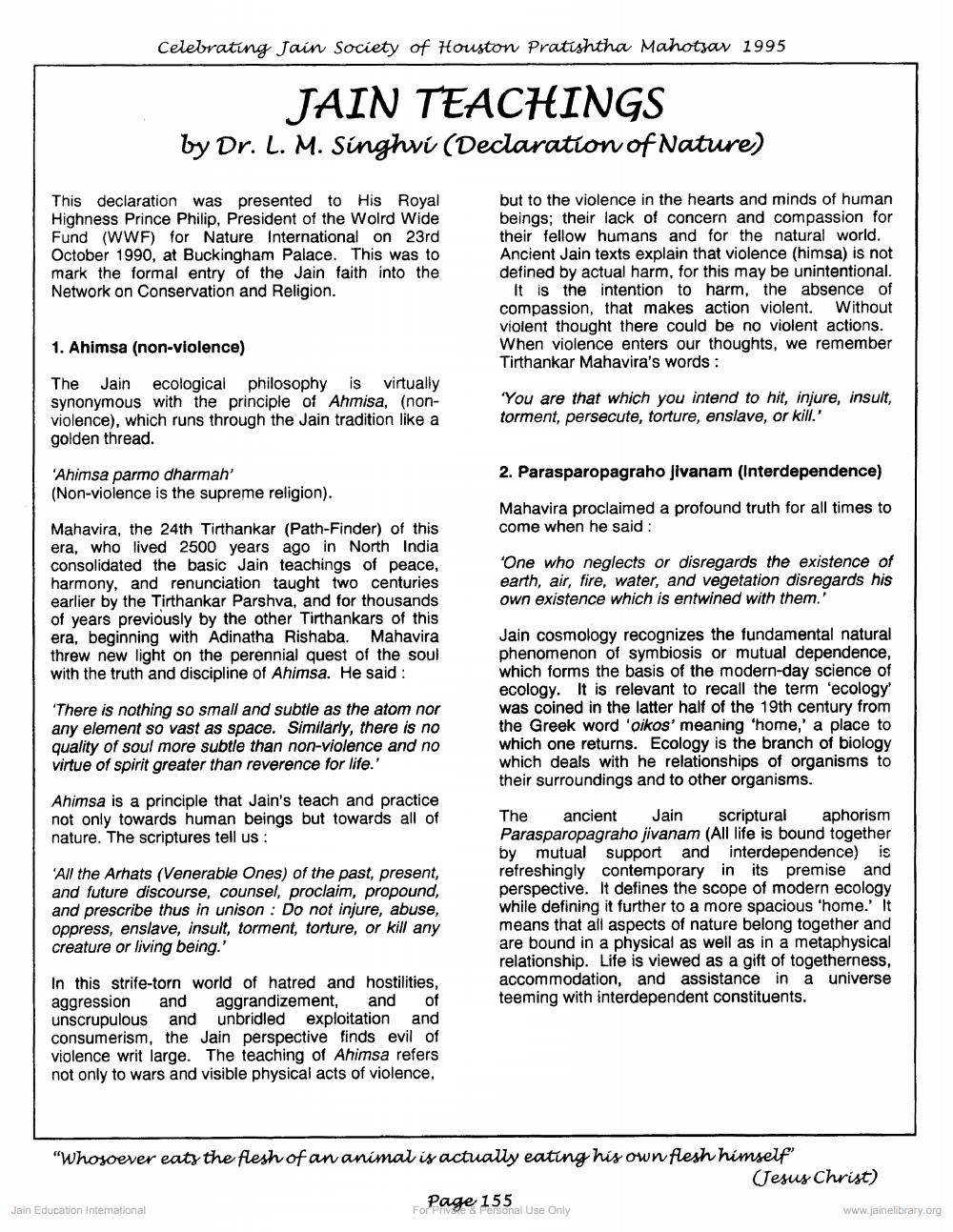________________
Celebrating Jain Society of Houston Pratishtha Mahotsav 1995
JAIN TEACHINGS by Dr. L. M. Singhvi (Declaration of Nature)
This declaration was presented to His Royal Highness Prince Philip, President of the Wolrd Wide Fund (WWF) for Nature International on 23rd October 1990, at Buckingham Palace. This was to mark the formal entry of the Jain faith into the Network on Conservation and Religion.
but to the violence in the hearts and minds of human beings; their lack of concern and compassion for their fellow humans and for the natural world. Ancient Jain texts explain that violence (himsa) is not defined by actual harm, for this may be unintentional.
It is the intention to harm, the absence of compassion, that makes action violent. Without violent thought there could be no violent actions. When violence enters our thoughts, we remember Tirthankar Mahavira's words:
1. Ahimsa (non-violence)
The Jain ecological philosophy is virtually synonymous with the principle of Ahmisa, (nonviolence), which runs through the Jain tradition like a golden thread.
'You are that which you intend to hit, injure, insult, torment, persecute, torture, enslave, or kill.'
2. Parasparopagraho Jivanam (Interdependence)
Ahimsa parmo dharmah' (Non-violence is the supreme religion).
Mahavira proclaimed a profound truth for all times to come when he said:
Mahavira, the 24th Tirthankar (Path-Finder) of this era, who lived 2500 years ago in North India consolidated the basic Jain teachings of peace, harmony, and renunciation taught two centuries earlier by the Tirthankar Parshva, and for thousands of years previously by the other Tirthankars of this era, beginning with Adinatha Rishaba. Mahavira threw new light on the perennial quest of the soul with the truth and discipline of Ahimsa. He said:
'One who neglects or disregards the existence of earth, air, fire, water, and vegetation disregards his own existence which is entwined with them.'
'There is nothing so small and subtle as the atom nor any element so vast as space. Similarly, there is no quality of soul more subtle than non-violence and no virtue of spirit greater than reverence for life.'
Jain cosmology recognizes the fundamental natural phenomenon of symbiosis or mutual dependence, which forms the basis of the modern-day science of ecology. It is relevant to recall the term 'ecology was coined in the latter half of the 19th century from the Greek word 'oikos' meaning 'home,' a place to which one returns. Ecology is the branch of biology which deals with he relationships of organisms to their surroundings and to other organisms.
Ahimsa is a principle that Jain's teach and practice not only towards human beings but towards all of nature. The scriptures tell us :
All the Arhats (Venerable Ones) of the past, present, and future discourse, counsel, proclaim, propound, and prescribe thus in unison : Do not injure, abuse, oppress, enslave, insult, torment, torture, or kill any creature or living being.'
The ancient Jain Scriptural aphorism Parasparopagraho jivanam (All life is bound together by mutual support and interdependence) is refreshingly contemporary in its premise and perspective. It defines the scope of modern ecology while defining it further to a more spacious 'home. It means that all aspects of nature belong together and are bound in a physical as well as in a metaphysical relationship. Life is viewed as a gift of togetherness, accommodation, and assistance in a universe teeming with interdependent constituents.
In this strife-torn world of hatred and hostilities, aggression and aggrandizement, and of unscrupulous and unbridled exploitation and consumerism, the Jain perspective finds evil of violence writ large. The teaching of Ahimsa refers not only to wars and visible physical acts of violence,
"Whosoever eaty the flesh of an animal is actually eating his own flesh himself
(Jesus Christ)
Jain Education Intemational
F Page 155
For Prve & Personal Use Only
www.jainelibrary.org




